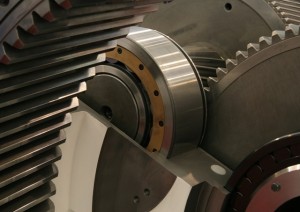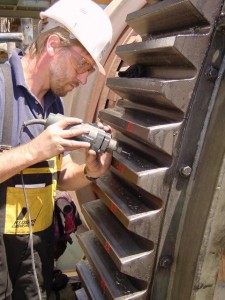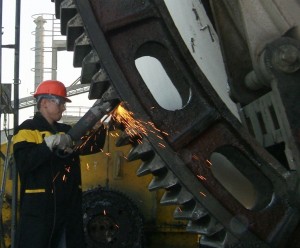Klüber Lubrication Offers Specialty Lubricants for Open Drives and Gears Keeping Mineral Processing Plants Up and Running
Authors: Daniel A. Narnhammer, Head of Global Competence Center Mining at Klüber Lubrication NA LPJustin Koozer, Cement and Mining Market Manager at Klüber Lubrication NA LP
To maintain the functionality of machinery in a mineral processing plant, several tons of lubricants are used for the numerous gearboxes, open drives, bearings, chains, compressors and other components each year. The rough operating conditions in the mining industry pose special challenges to lubricants. Among these challenges are, for example, high pressure, shock loads and vibrating stress as well as extreme temperatures and temperature changes, frequent, unforeseen stops and also low-speed operation, which the lubricants used have to withstand. Additionally, all structural components are subject to high dust and dirt particle concentrations in ambient air.
Open and closed gears are important structural components to consider in a mining plant when it comes to operational reliability and potential cost reductions. Transparent, adhesive lubricants for large open gear drives offer clear advantages over conventional black adhesive lubricants. A large share of the worldwide total open gears in operation, high- as well as low-speed, are already lubricated with these transparent fluids and their number is likely to increase in the near future. For closed gears, polyglycol-based lubricants are one option to considerably increase the degree of energy efficiency and, hence, to decrease operating costs.
Both manufacturers and operators can increase the efficiency of a plant
Generally, lubricants are required when surfaces sliding or rolling against each other need to be separated to ease mechanic friction. When deciding on a lubricant, it is important to consider various conditions to find the most efficient and cost-effective solution for a particular friction point. The following must be taken into account:
- The entire tribological system including the base body (e.g., the girth gear), opposing body (e.g., the pinion), intermediate substance (lubricant) and surrounding media (e.g., dust, environmental conditions, etc.).
- Influencing parameters such as condition of the gear, operating temperature, speed, vibrations, etc.
This complex subject matter does not only affect the manufacturers (OEM) of components and equipment for the production of minerals, but also the operators of mining plants. The consistent, application-oriented implementation of the evaluation procedure described above leads to significant cost decreases for maintenance and repair when conducted by operators of mining plants with the support of a tribologist or application expert.

Currently, most girth gears are lubricated with black adhesive lubricants. Operators have been familiar with this type of lubricant for decades, and are considered as the latest and best standard lubricant for this kind of application. Due to this long tradition, many operators are reluctant to change from black lubricants to transparent lubricants. They fear that they lack efficiency due to the lack of solid particles, but the advantages of transparent lubricants over black lubricants are very convincing:
- They are suitable for all kinds of open gear lubrication systems and do not block the system – not even parts of it (nozzles, tubes, etc.) as they do not contain any solid particles.
- They have proven to be successful in both mill and kiln drives and are suitable for high-speed and low-speed applications as well as for low- and high-temperature conditions.
- Significant reduction of lubrication quantities is possible, approximately 30-50 percent, sometimes even more, depending on the condition of the drive.
- As the lubricant film’s thickness exceeds that of conventional lubricants considerably, friction surfaces are optimally separated and softer engagement is achieved (significant reduction of vibrations and tooth flank temperature in operation).
- As the lubricant film is transparent, it is easier and safer to maintain and inspect the condition of the engaged tooth flanks.
- The drive is cleaner and more convenient to clean and maintain.
- Less and easier maintenance due to lower lubricant consumption.
- Reduction of storage costs and the required storage area.
- In summary, operation is much more efficient and economical.
As manufacturers of large gear drives, as well as the mining plant operators, require longer gear lifetime, less downtime and maintenance needs, the future of operational lubricants will be “transparent.” These state-of-the-art fluids, combined with the right professional support, e.g., technical and commercial before and after the sale service (cost monitoring, correct settings of spraying quantities, time intervals, etc.), are convincing more and more operators to replace a large part of the black adhesive lubricants step by step.
Synthetic oils increase the performance of closed gears
Closed gears play an ever-increasing role in mineral processing plants. The general industry demand for more performance at decreased operating costs also applies to them, as gears must transfer even more power while attaining a longer lifetime and requiring fewer downtimes. As the potential for constructional solutions offered by bearings, gear teeth, shafts and seals has been exploited in many cases, speciality lubricants have an important role to play.
Closed gears are normally lubricated with high-quality, doped mineral oils, which meet all requirements in terms of resistance to pressure, speeds and temperatures if the gear has been designed properly. With rising performance requirements, however, mineral oils reach their limit, especially in terms of thermal resistance. Oils with higher viscosity or fluid greases with extreme pressure or anti-wear additives are therefore needed. If the fretting risk is particularly high, there is a tendency to use synthetic oils, e.g., on the basis of polyalphaolefins (PAO) or polyglycols (PAG). Polyalphaolefins are miscible with mineral oils and extend oil-change intervals, compared to mineral oils approximately three-fold. Polyglycols, which are not miscible with mineral oils, extend oil change intervals even up to five-fold and increase the efficiency of closed gears by up to 10 percent. The potential energy savings generated with these oils lead to significantly lower operating costs.

The potential of specialty lubricants in combination with tribological knowledge, service and support is demonstrated by the following example:
A local mineral processing plant in South America was confronted with a problem of a worn-out double pinion mill drive, which was also subject to strong vibration. Due to serious damage (tooth crack, pitting, etc.), one production line was in danger of a longer unplanned maintenance interruption.
Klüber Lubrication was contacted for support, and immediately after having received the request, a service support team visited the plant in order to get a clear impression of the existing operating conditions. A thorough examination lead to the recommendation of a mechanical treatment for the complete gear, combined with a number of adjustment settings and a changeover from the low-budget standard open gear lubricant to Klüberfluid C-F 3 synthetic transparent lubricant, which provides a softer engagement, is free from heavy metals, bitumen, solid particles, etc. Although this kind of transparent fluid for the lubrication of open girth gear drives had not been used before, the responsible plant managers agreed to the suggestions of the tribology specialists.
Within six days, the necessary mechanical work was started, the lubrication system was checked and adjusted and repair lubrication was completed. During this time, the plant staff was trained by the service support team on mechanical treatment, on optimum adjustment and maintenance of lubrication systems and on how to choose and use the optimum lubricants in their areas of responsibility.

- Operating conditions have been improved considerably, as dangerous vibrations could be reduced significantly.
- Optimum separation of the friction partners due to a 10-times stronger lubricant film compared to the previously used lubricant, leading to an extended lifetime of the components. The result is reduced maintenance and material costs.
- The transparency of the lubricant film allows for constant monitoring of the repaired tooth flanks even when the mill is running. Any possible problems can be anticipated easily, and the right type of action can be planned and initiated in time. This possibility of preventive maintenance leads to increased operational safety.
- Due to the high quality of the new open gear lubricant, relubrication intervals can be extended significantly, which results in a reduction of the lubricant consumption by at least 50 percent.
Summary
Operators aim at preventing failures, lowering operating costs and increasing production quantities. Although it is often underestimated, the right lubricant can contribute significantly to obtaining these goals by providing an optimum separation of the friction partners even under extreme conditions, extending maintenance and oil-change intervals, as machines do not have to be relubricated as often. Costs for spare parts can be saved, as the right lubricant reduces wear and considerably increases the life of components. This also results in fewer failures and greater machine efficiency, so that targeted production quantities can be achieved and even increased. To make use of the full potential, it is important to involve tribologists and application experts in the development process of machinery components for mining plants. The operators of existing plants should also consult tribologists to optimize their plant’s operation.
For more information:
Klüber Lubrication
Phone: (800) 447-2238
www.klueber.com




 Power Transmission Engineering is THE magazine of mechanical components. PTE is written for engineers and maintenance pros who specify, purchase and use gears, gear drives, bearings, motors, couplings, clutches, lubrication, seals and all other types of mechanical power transmission and motion control components.
Power Transmission Engineering is THE magazine of mechanical components. PTE is written for engineers and maintenance pros who specify, purchase and use gears, gear drives, bearings, motors, couplings, clutches, lubrication, seals and all other types of mechanical power transmission and motion control components.